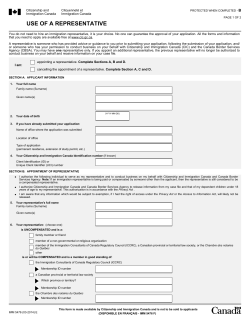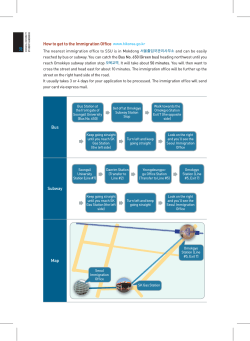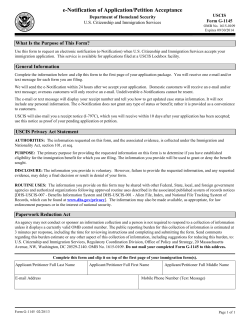
secure the border first
To: From: Date: Re: Interested Parties Frank Sharry, Executive Director of America’s Voice April 2015 2016 Republicans and Immigration – What They Say, What They Mean, & Why it Matters As the 2016 presidential cycle kicks into higher gear, the emerging Republican field is stuck between an anti-immigrant rock and a demographic hard place. Already, immigration is emerging as Republicans’ kryptonite, as potential GOP candidates are once again pandering to anti-immigrant primary voters. At the same time, the prospect of a demographically diverse general electorate looms after the primaries. In every likely 2016 battleground state, the Latino and Asian-American share of eligible voters has grown since 2012. Republicans seeking the presidency seem aware of the mistakes made by Mitt Romney in this regard in 2012, when his anti-immigrant primary stances helped destroy his general election competitiveness with Latino, Asian-American, and other pro-reform voters. But rather than staking out a strong position in favor of comprehensive immigration reform, most in the 2016 Republican field appear to be trying out new sound-bite “solutions,” the goal of being vague enough to appeal to hardliners in the primary without alienating general election voters. That Gov. Scott Walker is in hot water for seemingly contradictory statements on the subject, including his recent “report to deport” idea, speaks to the larger precarious nature of the field’s immigration positioning. Most GOP candidates seem to share a basic talking point: “secure the border first” while opposing “amnesty” and President Obama’s executive action programs. That leaves essential immigration questions about policies for the undocumented open to interpretation. By adopting these positions, the GOP field is, at best, kicking the can down the road on progress for undocumented immigrants and embracing inaction and, at worst, advancing policy positions that would maximize deportations and rip apart families. Throughout the 2016 election cycle, America’s Voice will track candidates’ immigration positioning and offer ongoing analysis at: http://AmericasVoice.org/2016 (individual candidate profiles already available). To kick off our 2016 work, this memo explores three of the essential immigration issues to understand in following the Republican presidential field: 1 ● Why “Secure the Border First” is a Vacuous Excuse for Inaction: This phrase, popular throughout the GOP field, is a political sound bite that has nothing to do with the real state of border security, but is used as an excuse to avoid broader immigration reforms. ● The Heart of the Debate: What is Your Plan for 11 Million Undocumented Immigrants? Most in the GOP field are refusing to provide specifics on this question, preferring to punt to the aforementioned “border first” language and railing against “amnesty” and executive action, without clearly laying out what they would do to address the status of millions of immigrants rooted in America. ● Why You Can’t Be “Pro-Immigrant” and Support Ending DACA/DAPA and Executive Action Programs: While the candidates are universal in opposition to executive action, some think they can soften this opposition with vague promises to pass a permanent legislative fix. But voters will not be fooled. Candidates who pledge to end DACA and DAPA ignore the close ties between many Latino voters and undocumented immigrants and will face harsh questions on their specific plans as the election cycle unfolds. For each of the above topics, we present a series of key questions that GOP contenders should be asked and made to answer as they audition for the most powerful position in the world. In the final pages, we analyze the demographic inevitability facing the eventual Republican nominee; how the diversity challenge for the GOP has grown even more acute since 2012; and how, in the face of these demographics, Republicans have failed to learn the right lessons from Mitt Romney’s defeat. 2 Why “Secure the Border First” is a Vacuous Excuse for Inaction To a remarkable degree of unanimity, the Republican presidential field agrees on the “secure the border first” concept. From Jeb Bush to Marco Rubio to Scott Walker to Rand Paul to Ted Cruz, each has voiced support for the “secure the border first” concept. It has the illusion of common sense – who wouldn’t want to secure the border? But, in actuality, it is a recipe for never actually tackling real reform. How are the candidates defining a “secure” border? Who gets to decide – the same Members of Congress who are opposed to immigration reform and blocked it last Congress? The same border patrol agents on the ground who are openly antagonistic toward deportation reforms and worried about securing their own jobs first? Should we trust Republicans to fairly evaluate the state of the border when the person responsible for securing it is a Democrat and they look to unseat Democratic candidates up and down the ballot? This is the politicization of border security. In fact, “border security first” has become a coded way to say “comprehensive immigration reform never.” It’s an excuse to do nothing regarding the status of undocumented immigrants; a claim at odds with the real facts on the ground; a purposeful ignoring of the tremendous resources and expenditures already devoted to the border; and an invitation to “move the goalposts” and manipulate the security metrics so as to perpetually declare an insecure border and keep kicking the can down the road. As Paul Waldman assessed in the Washington Post: “’Secure the border first!’ is an utterly hollow position, because it’s never followed by any specificity about how we’ll know when the border is ‘secure.’ So long as even a single immigrant can find a way in, it will be possible for Republicans to say that the border is not yet secure, so we can’t enact any of the other parts of immigration reform.” From a policy perspective, the focus on “border first” also reflects a fundamental, or willful, misunderstanding of immigration policy. The best way to secure the border is to fundamentally overhaul the current broken system and its misaligned incentives by passing comprehensive immigration reform. Only by simultaneously addressing border and interior enforcement, visa reforms to better align legal immigration with economic realities, and implementing a serious plan for the undocumented population to come forward and earn legalization and citizenship, can you expect to overhaul the broken status quo and forge a new and workable immigration system. As the Wall Street Journal editorialized: “Republicans who claim we must ‘secure the border first’ ignore the progress already made because their real goal isn’t border security. It is to use border security as an excuse to kill immigration reform.” 3 Here are the facts: we already spend unprecedented sums, devote unprecedented resources, and have made unprecedented progress at the border. ● As a nation, we have mounted an aggressive “enforcement-first” strategy for the past 20 years. Currently, according to the Migration Policy Institute, we spend more on immigration enforcement than on all other federal law enforcement efforts combined. ● The Obama Administration has deported a record number of immigrants compared to previous Administrations. ● Nearly all of the border security metrics contained in the Senate’s 2007 immigration bill have been met. ● The Senate immigration bill that passed in 2013 on a bipartisan basis had the toughest border security provisions in American history, and it still wasn’t “tough enough” for most Republicans. Notably, the public – especially Latino voters – just doesn’t buy the “border security first” excuse. A September 2014 NBC News/Wall Street Journal poll asked, “When you hear Republicans say that immigration reform must wait until the border is secure, do you think that is a legitimate concern that needs to be addressed first before immigration reform can take place, or they are using that as an excuse to block action on immigration reform?” Overall, 40% of voters believed this was a “legitimate concern” vs. 52% who viewed this as an excuse to block immigration reform (the “excuse” number was 66% among Latino respondents). A June 2013 Latino Decisions poll asked Latino voters whether “a pathway to citizenship must wait until after the border is fully secure” or if the nation should pursue immigration policy that simultaneously dealt with border security and a path to citizenship. Overall, 81% of Latino voters, including 66% of self-identified Latino Republicans – preferred addressing both together. Latino Decisions July 2013 polling in 24 Republican-held congressional districts also found that 66% of Latino voters viewed the border-first concept as “an excuse to block a path to citizenship, rather than a legitimate concern.” In fact, the majority of voters support a both/and rather than an “either/or” approach to unauthorized immigration. That is, they support stronger enforcement and a path to citizenship for undocumented immigrants, not one at the expense of the other. Key Questions on “Secure the Border First”: ● “How do you define a ‘secure’ border?” ● “The nation has met or surpassed key border security metrics established in the 2007 Senate bill on border security, border barriers, operational control of the border, and increased consequences for “illegal crossing” – why isn’t that enough?” ● “Who would be responsible for measuring and assessing border security – Members of Congress? Border patrol agents? Your administration?” 4 ● “Why can’t you tackle both security and broader reform at the same time? Isn’t this the best thing to do for security, the economy, and the American people?” The Heart of the Debate: What is Your Plan for 11 Million Undocumented Immigrants? During a February 2015 town hall event in Miami, President Obama focused attention on the essential immigration policy question to ask of Republican candidates. When discussing Republican outreach to Latino voters, President Obama said: “When they start asking for votes, the first question should be, ‘Do you really intend to deport 11 million people?...And if not, what is your plan to make sure that they have the ability to have a legal status, stay with their families and, ultimately, contribute to the United States of America?’” In addition to its other problematic elements, the “secure the border first” phrase allows candidates to avoid answering the President’s question or specifying what their plan is for the undocumented population in the nation. For example, Senator Ted Cruz recently refused to specify his position for undocumented immigrants, instead punting on a question by the friendly interviewer Sean Hannity. In response to Hannity’s question regarding the 11 million undocumented immigrants, Cruz said, “You don’t have to answer every question one at a time,” and then offered paeans to border security and legal immigration, while attributing the focus on the 11 million to Democrats’ desire to have that “divisive” issue remain politically salient. However, addressing the status of undocumented immigrants remains the heart of the immigration debate and the most essential – and intractable – component of the policy battles. Only by simultaneously addressing a way forward for the undocumented alongside other reforms can you actually expect to overhaul the current system. And as Senator Lindsey Graham told CNN: "If we [Republicans] don't at least make a down payment on solving the problem and rationally dealing with the 11 million [people in the country illegally], if we become the party of selfdeportation in 2015 and 2016, then the chance of winning the White House I think is almost nonexistent.” There are three potential policy directions for undocumented immigrants settled in the United States: an embrace of the status quo and/or inaction; endorsement of a deportation-focused approach; or advocacy for earned legalization and/or citizenship. Many in the GOP field, such as Gov. Scott Walker, rail against “amnesty” without defining what that constitutes. The fact is, the earned path to citizenship at the heart of comprehensive reform proposals are a far cry from “amnesty” and would include a number of requirements, such as passing a background check, studying English, and paying taxes owed. 5 Meanwhile, Jeb Bush has been hinting at support for legalization, short of citizenship. But this is an option that seems to satisfy no one – neither the anti-immigrant zealots overrepresented in the Republican primary nor the general election voters interested in permanent solutions in line with our values as a nation. According to polling, it’s an idea in search of a constituency. In February 2015, Public Religion Research Institute (PRRI) released the American Values Atlas, which features the results from more than 40,000 phone interviews with the public. The polling found that 60% of the public supports a path to citizenship, while only 17% support legalization without citizenship, and only 19% support a deportation-focused policy for undocumented immigrants in America (the policy position closest to the majority of Republican Members of Congress during the past two years). In fact and despite the political debate, Americans’ support for immigration reform and a pathway to citizenship remains durable, with a consistent two-thirds or more of the public backing a path to citizenship both before and after the November 2014 executive action announcement. In particular, when the public is presented with a detailed overview of the requirements inherent to “earning” legalization and eventual citizenship, the polling support climbs even higher. Key Questions on Status for Undocumented Immigrants: ● “What is your plan to address the status of the 11 million undocumented immigrants in this country?” ● “Provided the border is ‘secure’ to your satisfaction, what policy do you support for undocumented immigrants settled in the United States?” ● “What constitutes ‘amnesty’ in your eyes?” Why You Can’t Be “Pro-Immigrant” and Support Ending DACA/DAPA and Executive Action Programs In Congress and in the courts, Republicans have been singularly obsessed with ending, blocking and reversing President Obama’s immigration executive action programs, announced last November. The story is the same on the presidential campaign trail, where every single candidate has come out in opposition to executive action. Candidates such as Jeb Bush couch their opposition to DACA and other executive action programs with their support for passing permanent legislation to address the status of the undocumented. They believe this is a way to thread the needle with pro-immigrant voters, but they don’t seem to understand that it’s impossible to be “pro-immigrant” if want to end these immigration programs that help them. Endorsing the end of executive action programs ignores the close ties that exist between undocumented immigrants and Latino voters (whether native-born or naturalized U.S. citizens): 6 ● 2013 Latino Decisions polling of Latino undocumented immigrants found that 85% of undocumented immigrants reported having a family member who was a U.S. citizen. Among these, 62% had at least one U.S. born child, 29% had a spouse who is a U.S. citizen or legal permanent resident, and an additional 20% had another family member who was a U.S. citizen, such as a sibling, niece or nephew, aunt or uncle ● Polling from Latino Decisions, conducted on behalf of the RWJF Center for Health Policy at the University of New Mexico, found that 61% of Latinos, regardless of citizenship status, reported knowing someone that is undocumented. Additionally, 36% of Latinos know someone that has been detained and/or deported, and 46% of all Latinos worry that a friend or family might be detained or deported due to their immigration status. ● A recent study from University of Southern California’s Center for the Study of Immigrant Integration estimated that there are almost 600,000 eligible voters whose parents could benefit from the DAPA executive action program – a figure that could rise to 1.7 million by the year 2020. So far, Republican candidates have been able to avoid declaring when they would end the executive actions. Would they end DACA and DAPA in the first 100 days? Would they stop processing applications immediately? Or would they keep these programs in place until/unless Congress finally does its job and passes immigration reform legislation that could supplant these temporary measures? The answers to these questions matter greatly, because even if Congress begins to tackle immigration reform in the first few months of 2017, it is unlikely to pass overnight. Under the most optimistic assessments, passing a reform package through Congress would take months, if not years, and, given the issue’s history, is far from guaranteed. Immigrants and their voting-age citizen relatives want to know if they can count on the next president to keep policies in place until the legislature finally enacts a permanent solution. Key Questions on Opposition to Executive Action: ● “As President, when would you end DACA and DAPA programs? The first 100 days? Sooner? Would you stop processing applications for DACA and DAPA immediately?” ● “What would happen to DACA and DAPA-eligible immigrants after you end those programs? Would they be subject to deportation?” Post-2012: GOP Lurches to the Right, Despite Relentless Demographic Trends Following the last presidential election cycle in 2012, most political observers agreed with the following two points: 1. In order to recapture the White House, Republicans needed to improve their competitiveness with Latino voters. In the 2012 election, according to in-depth Election Eve polling Mitt Romney received just 23% of the Latino vote (media-sponsored exit polls had him receiving 27% of the Latino vote) 7 2. In order to improve their competitiveness with Latino voters, Republicans needed to change their image as an anti-immigrant party and share credit for passing immigration reform. Romney’s hardline immigration stance, epitomized by his infamous call for “self-deportation,” encapsulated the fact that the Republican brand was increasingly viewed as anti-immigrant and anti-Latino. For example, in March 2013, the post-election autopsy report from the Republican National Committee (RNC) reflected this emerging consensus: “We must embrace and champion comprehensive immigration reform….If Hispanic Americans hear that the GOP doesn’t want them in the United States, they won’t pay attention to our next sentence…Hispanic voters tell us our Party’s position on immigration has become a litmus test, measuring whether we are meeting them with a welcome mat or a closed door.” However, despite the stark recommendations from the RNC and the cautionary tale of the Romney campaign, the Republican Party is now moving in the exact opposite direction. Following an initial move towards immigration reform by a number of prominent Republicans, over the past two years the GOP has lurched to the right, embraced hardline policies and cemented their anti-immigrant brand image. The facts are clear: In the last Congress, the Republican-controlled House of Representatives blocked the best chance in a generation to pass comprehensive immigration reform; on the campaign trail in 2014 Republican candidates ran hard to the anti-immigrant right; and now the GOP is embroiled in high-profile battles seeking to undo President Obama’s executive actions that promise relief and work permits to protect millions of undocumented immigrants. The Republican move to the anti-immigrant right flies in the face of their need to improve their appeal to non-white voters – an imperative that is becoming even more acute. While some analysts believe the GOP can prosper by expanding the number and percentage of White votes, most operatives – including Karl Rove – argue that exceeding Mitt Romney’s 59% total share of the White vote is highly unlikely. Moreover, a recent state-by-state breakdown from Patrick Oakford at the Center for American Progress demonstrates that the Latino and Asian-American share of the eligible voter electorate has grown in every likely 2016 battleground state compared to 2012. Further, the report found that, even if the Republican nominee achieves Romney’s high level of White voter support, the changing demographics of the electorate will make it harder for the candidate to win: “If Democrats are able to retain high levels of support among voters of color in 2016 as they did in 2012, then they will more easily win battleground states such as Virginia, where Democrats’ margin of victory would increase by more than one-third. More importantly, Democrats could win back some states they lost in 2012, including North Carolina. Republicans will need to secure a rising level of support among voters of color in order to compete in key states in 2016. In some states, such as Florida, restoring party preferences to their 2004 levels would enable the GOP to narrowly win back states they lost in 2012 but had won in previous elections. However, in order to win back other key states that the GOP won in 8 2004, such as Ohio and Nevada, the GOP would need to exceed the share of support it received from voters of color in 2004.” Echoing the above assessment are the numbers central to a report by Rob Paral of the Immigration Policy Center, which highlighted that more than 3 million Latino and Asian-Americans now become eligible to vote in each two-year election cycle (approximately 1.8 million who turn 18 and an additional 1.4 million Latinos and Asian-Americans who are naturalized as new citizens and new potential voters). In 2014 Election Eve polling from Latino Decisions, 20% of Latino voters said they planned to vote Republican in the 2016 presidential election, while 52% were committed to the Democrats. This leaves approximately a quarter of Latino voters – 28% -- undecided or nominally up for grabs. Given that most observers believe a Republican candidate has to win at least 40% of the Latino vote to have a chance at winning the presidency (the last GOP candidate to do so was George W. Bush), the Republican field knows what is at stake in regards to immigration and their appeal to non-white voters. Republican pollster Whit Ayres encapsulated the challenge for the GOP field, noting a “brand problem for Republican candidates in non-white communities in general and Hispanic communities in particular. While inclusive and welcoming Republican candidates can overcome the brand, the burden of proof is on them to do so.” As Chris Cillizza of the Washington Post recently wrote: “The simple fact is that Republicans can't simply hope that that the trend line on the Hispanic vote magically changes … the fight over immigration reform happening in Congress and in the early stages of the 2016 presidential race could very well set back the party's attempts to make inroads with voters who are absolutely critical to their future as, well, a party. Demographics might not be destiny. But Republicans are staring at the wrong end of a demographic transformation that threatens to upend the current political map.” For more information, visit http://AmericasVoice.org/2016 or contact press@americasvoiceonline.org 9
© Copyright 2025









